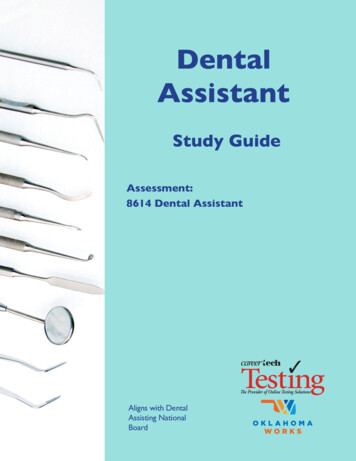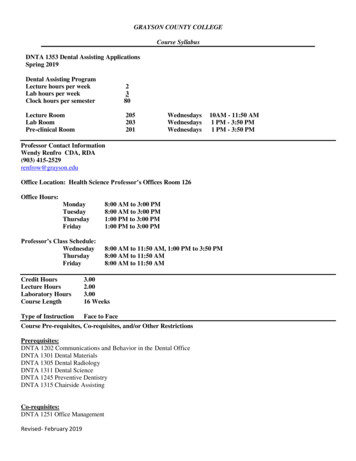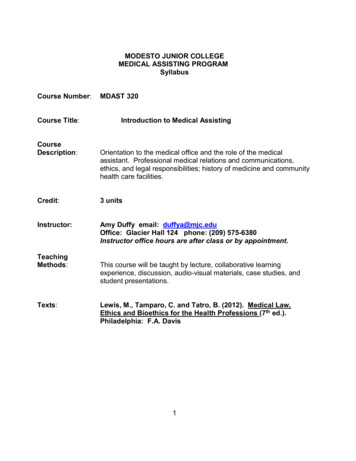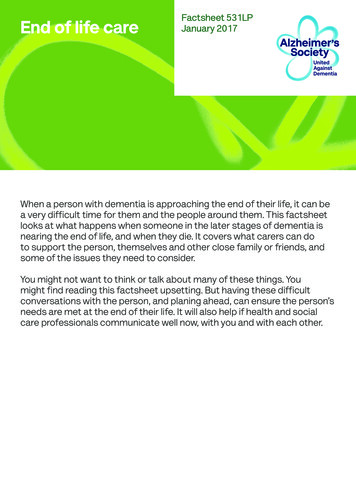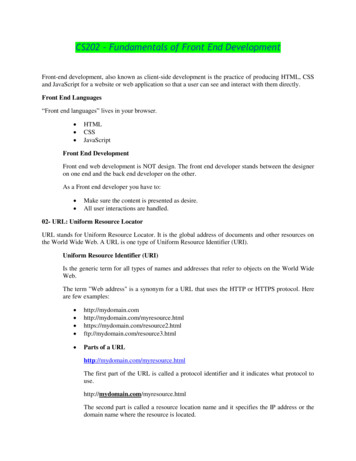
Transcription
2/10/2014Assisting with End‐of‐LifePlanningThis webinar series is made possiblethrough the generous support of theRetirement Research FoundationPresented byJean Correll MunnandJeannine Wilson.Nursing Home Social Work NetworkWebinar SeriesJean Correll Munn, Ph.D., M.S.W.Jeannine Wilson, LSWCollege of Social WorkFlorida State University PHOTODirector of Social ServicesDr. Jean Correll Munn received her Ph.D. andBio in Social Work from the University ofMaster’sNorth Carolina at Chapel Hill and her B.A. inPsychology from Duke University. As a doctoralstudent, she was awarded a John A. HartfordDoctoral Fellowship to complete herdissertation: Defining a Good Death forResidents in Long‐Term Care. She receivedadditional dissertation support from the DukeInstitute on Care at the End of Life. In 2007 Dr.Munn became a John A. Hartford GeriatricSocial Work Faculty Scholar and a College ofPalliative Care Scholar. Dr. Munn was promotedto Associate Professor and awarded tenure in2012. Currently, she is directing the multi‐disciplinary Certificate in Gerontology at FSU. PhotoGreenwood Center, Sanford, MEJeannine Wilson earnedher LSW, Bachelor degreein Social Work fromUniversity of SouthernMaine. Director of SocialServices of an 86 bednursing and rehabilitationfacility in Southern Maine.Member of the MainePOLST coalition.34ObjectivesOVERVIEWUpon completion of this webinar, participantswill be able to:1. Interpret the role of the social worker in long‐term care at the end of life;2. Identify advance directives including thePOLST; and3. Understand the role of documentation. Defining the Social Work RoleInitiating the Conversation Describing Advance Directives Introducing The POLST– Barriers– Timing– Types– Challenges– Description– Legal Implications– Clinical Implications – Principles of good documentation– Specifics related to end of life– Continuity of Care 5DocumentingContinuing the ConversationCase Study61
2/10/2014Defining the Social Work Role NASW StandardsRegulatory RequirementsThe Interdisciplinary TeamEmpirical StudiesThe Real World The NASW directive states that social workersinvolved in end‐of‐life or palliative careshould: “advocate for the needs, decisions,and rights of clients” and “ensure that peoplehave equal access to resources to meet theirbiopsychosocial needs in palliative and end oflife care.”78Initiating the ConversationInitiating the ConversationBarriersTiming Personal Concerns: Values Pre‐admission Goals– Social Worker– Resident– Resident Family– Home– Home with services Palliative Care Hospice care Facility Policies Legal Concerns– Long term care Palliative care Hospice Care910Advance DirectivesInitiating the ConversationTypesStakeholders Surrogate – Health Care Power of Attorney (HCPOA)– Legal hierarchy (state specific) Instructional– Living will– Do Not Resuscitate (DNR)11GoalsAdvanced Directives/ Living WillMPOAGuardianDHHS GuardianRepresentativeCapacityShared Decision Making122
2/10/2014The POLSTPhysicians Order for Life Sustaining TreatmentAdvance DirectivesChallenges An AlternativeResidents without advance directivesInterpretation and applicability disagreementsDocument portability problemsEnforcement shortcomings What is the POLST?– Originated in Oregon– Medical order signed by a doctor– With concurrence of resident or resident’ssurrogate– Instructing health care providers of resident’swishes under factual conditions. Delineates specific circumstances Works in conjunction with other ADs– Voluntary rather than mandated1314The POLSTThe POLSTLegal ImplicationsClinical Implications POLST provides more precise informationregarding specific treatment options in uniquemedical circumstances. Residents with POLSTs are more likely to:– Have care more consistent with their desires andvalues– Have consistent care across settings of care– Remain in the nursing home Reduces stress on care providers and familymembers1516The POLST Conversation DHHS Guardian POLST ProcessReviewing the Advanced DirectivesExplaining the POLST termsAccurate informationPOLST BrochureExplaining the Dying Process ConversationAdvanced Directives/ Prior code StatusLetter from DoctorCompleted POLST signed by doctorSASE– Pain– Hunger– Thirst17183
2/10/2014DocumentationMDS 3.0Purpose Include Advance Directive review: The purpose of documentation “to providethe team with the necessary information tocare with and for the resident” and for clinical,ethical, and legal accountability While utilizing sensitive information only tothe extent that it is necessary for optimalresident care (Beaulieu, 2012) .– At the annual assessment;– During assessments for significant changes;– Upon discharge; and– Upon re‐admission.19DocumentationDocumentationThe Medical ChartThe Medical Chart Legal Documents in the Medical Chart: 20 Social WorkerAdmissions AgreementLiving WillHealth Care ProxyDurable Power of AttorneyGuardianship Reviews on a regular basis;Assesses for current appropriateness;Examines for expirations; andContinues the conversation.This is a cific to End of Life Good documentation (Sidell, 2011):– Focuses on service delivery;– Includes assessments that are objective,comprehensive, and fair;– Is information focused;– Identifies important cultural factors;– Is written as if the client and others involved haveaccess; and– Is organized, current and well‐written. Ensure that the wishes of the resident are heardthroughout the initial and ensuingconversation(s). Acknowledge the clinical and legal decisions thathave been made.23– Initiation of or– Changes to advance directives. Provide consistent information to all members ofthe health care team regardless of residentcapacity or location.244
2/10/2014DocumentationContinuity of CareContinuity of careDischarge or Transfer Example of Process POLST is to accompany resident on dischargedto the hospital POLST is to accompany resident when makinga visit to a specialist POLST is to accompany resident whentransferred by ambulance POLST is to accompany resident when goinghome– Have POLST policy in place for facility– 5 copies in front of chart(on lime green #24)– Original in doctor’s orders section– Orange stickers inside cover (DNR, DNH)– Standard Doctor’s order for MAR See POLST for further instructions– Update Demographics' Sheet– Copy sent to PCP on discharge (Mailed)25The Conversation continues 26Case StudyConflicting opinionsFamily wants to decide for capacitated personDoes not match Advanced DirectiveGuardianshipMrs. Parkhurst, age 80, was admitted to a Dementia Care Center by her son.She was now in the middle stages of dementia and not able to make decisionsfor herself. Her son Michael is her Medical Power of Attorney. He was askedby the social worker to meet with her about completing a POLST. Michaelshowed Mrs. Parkhurst Advanced Directive to the social worker that she hadcompleted when she was 67, that indicated full code.He also spoke to the SW in detail about a dinner he had had with his motherabout two years earlier and she said to him at the time if she ever haddementia and wasn’t able to make decisions for herself she did not want tohave any extraordinary means taken to extend her life. He remembered thedate of the dinner and the name of the restaurant where they had thisconversation.1. Who should be included in this decision?2. How should Mrs. Parkhurst’s son complete her POLST?3. What should be documented in the SW notes?27Case Study28Key ResourcesQuestions for ReflectionBeaulieu, E.M. (2012). A guide for nursing home social workers. New York:Springer.1. How should Mrs. Parkhurst’s son completeher POLST?2. Who should be included in this decision?3. What should be documented in the SWnotes?Kapp, M. (2012). The nursing home as part of the POLST paradigm. 36Hamline Law Review, Symposium Edition.Munn, J.C. & Adorno, G.F. (2008). By invitation only: Social work involvementat the end of life in long‐term care. Journal of Social Work in End‐of‐Life andPalliative Care, 4(4), 333‐357.POLST Physicians Order for Life Sustaining Treatment http://www.polst.org/Sidell, N.L. (2011). Social work documentation: A guide to strengthening yourcase recording. New York: NASW Press29305
2/10/2014Thank you.A recording of this webinar is availablethrough the National Nursing Home SocialWork Network �home/webinars6
Assisting with End‐of‐Life Planning Presented by Jean Correll Munn and Jeannine Wilson Nursing Home Social Work Network Webinar Series This webinar series is made possible through the generous support of the Retirement Research Foundation. Jean Correll Munn, Ph.D., M.S.W. College of Social Work
